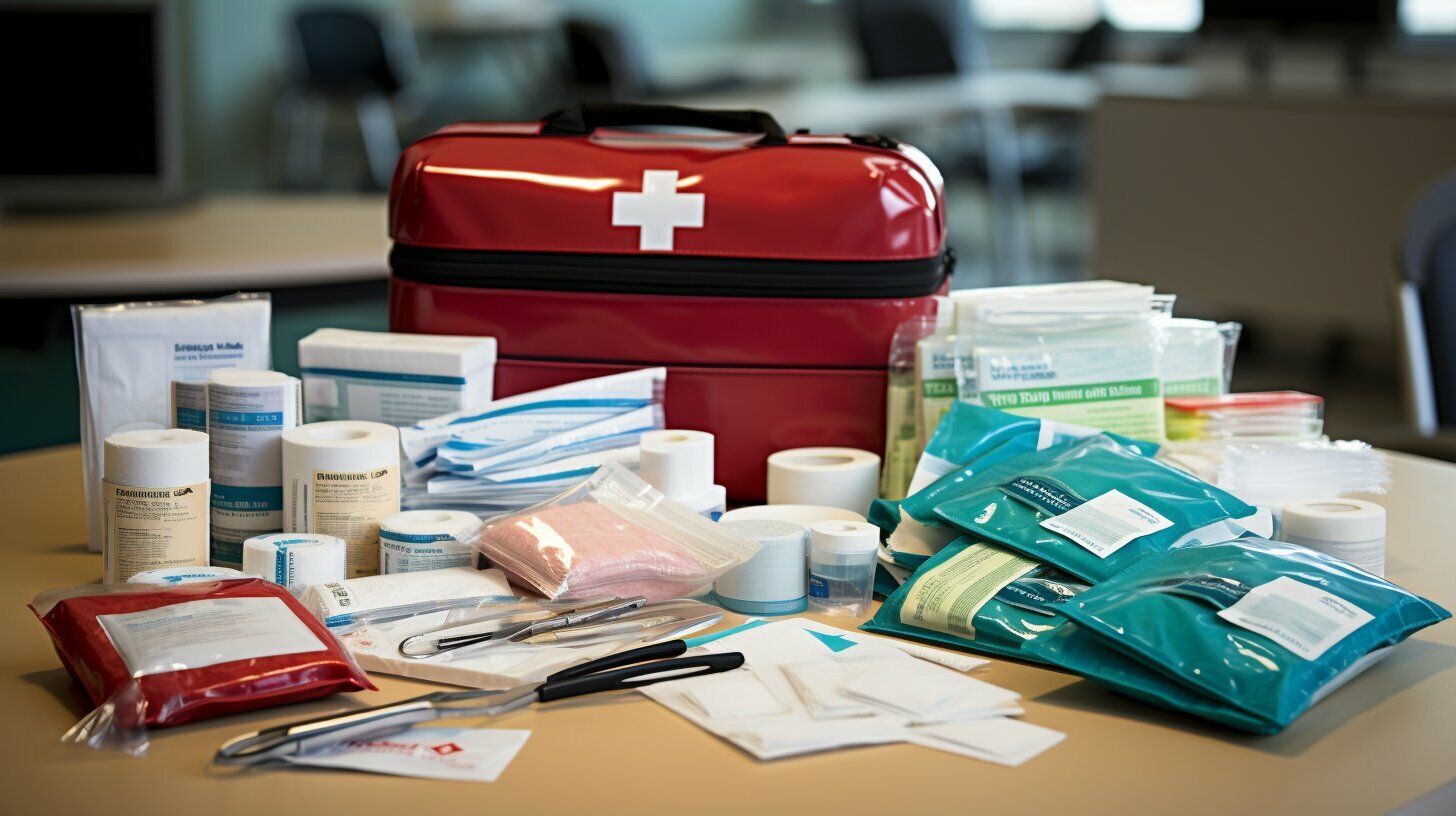The UK’s National Health Service (NHS) strongly recommends having a well-stocked first aid kit to address potential health emergencies in various settings. Whether at home, in the car, or at the workplace, being prepared with the right first aid supplies can make a significant difference in providing initial care before medical professionals arrive.
When it comes to assembling your first aid kit, the NHS provides valuable recommendations to ensure you have the essential items on hand. These supplies include plasters of various sizes, sterile dressings, eye dressings, bandages, gloves, tweezers, scissors, cleansing wipes, tape, thermometer, rash cream, insect bite relief, antiseptic cream, painkillers, antihistamine cream or tablets, distilled water for cleaning wounds, and eye wash. By having these items readily available, you can quickly respond to common injuries and illnesses.
The Importance of Being Prepared
In the event of a health emergency, having access to emergency first aid supplies can make a significant difference in providing immediate care. When faced with a sudden injury or illness, having the necessary medical supplies readily available can help stabilize the situation until professional help arrives. This is why the UK’s National Health Service (NHS) strongly emphasizes the importance of being prepared by having a well-stocked first aid kit at home, in the car, and in the workplace.
A basic first aid kit should include essential items such as plasters of various sizes, sterile dressings, eye dressings, bandages, gloves, tweezers, scissors, cleansing wipes, tape, and a thermometer. These supplies, recommended by the NHS, are crucial for providing initial care during emergencies. Additionally, including items like rash cream, insect bite relief, antiseptic cream, painkillers, antihistamine cream or tablets, distilled water for cleaning wounds, and eye wash can further enhance the ability to address a wide range of health emergencies.
Regularly checking the expiry dates of medicines in your first aid kit is also important. Expired medications may be ineffective and potentially harmful, so it is essential to ensure that all supplies are up to date. By maintaining a well-stocked and up-to-date first aid kit, individuals can effectively respond to health emergencies with confidence and provide immediate care when it is needed most.
Emergency First Aid Supplies Image
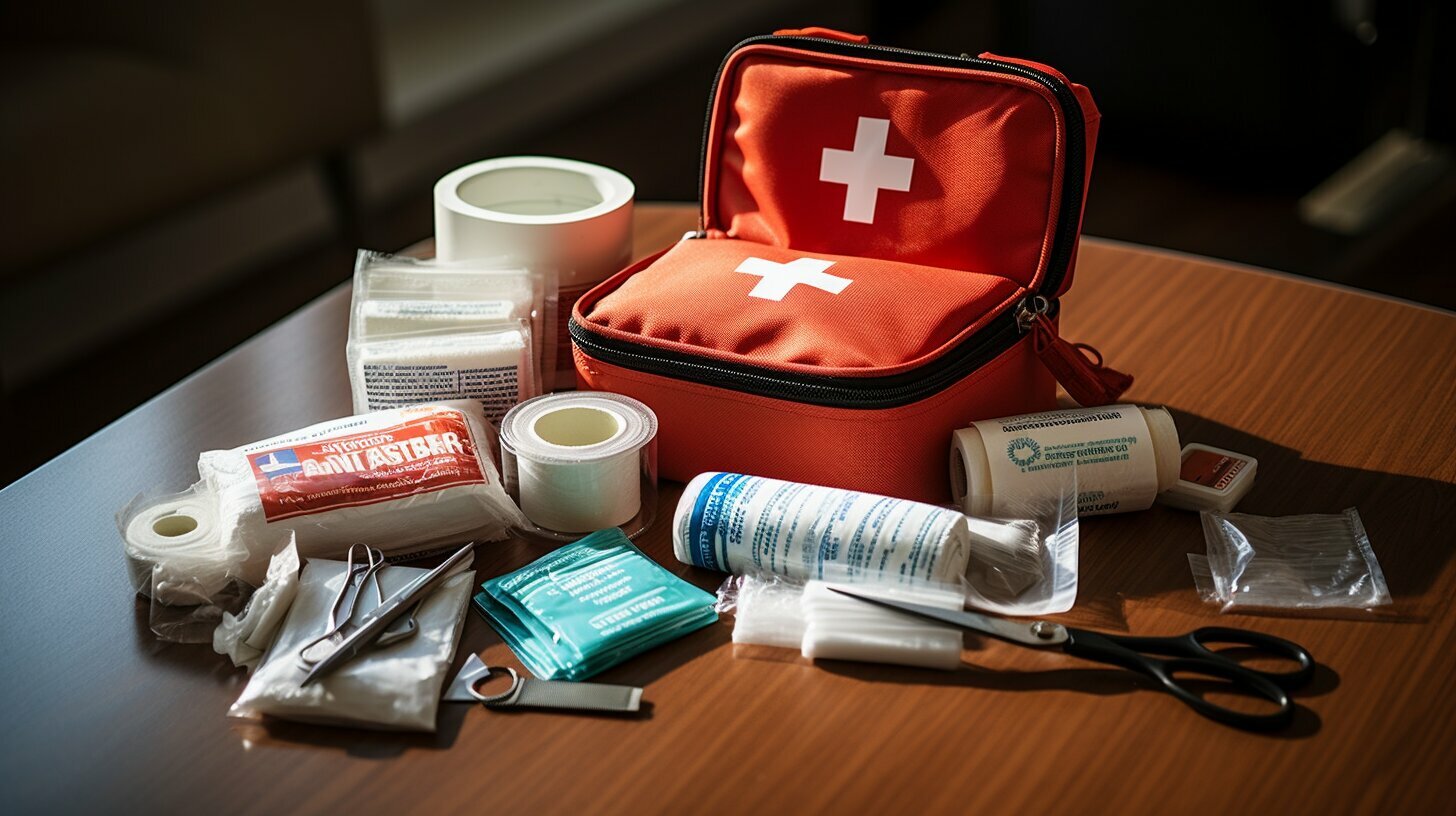
| Essential First Aid Kit Supplies | Additional First Aid Kit Supplies |
|---|---|
|
|
Alongside providing recommendations for first aid supplies, the NHS offers comprehensive guidance on various aspects of first aid. This includes information on appointed persons, defibrillators, electric shock treatment, first aid box contents, first aid equipment, first aid for the public, first aid for traveling or lone workers, first aid in schools, and first aid room requirements. Safety measures, such as using first-aid signs, determining the number of first-aiders needed, and minimizing the risk of cross-infection during first aid procedures, are also covered.
Basic First Aid Kit Essentials
A well-stocked first aid kit should include a range of items such as plasters of various sizes, sterile dressings, eye dressings, bandages, gloves, tweezers, scissors, cleansing wipes, tape, and a thermometer. These essential supplies are recommended by the UK’s National Health Service (NHS) to ensure you are prepared for common injuries and emergencies.
Plasters, also known as adhesive bandages, are crucial for covering and protecting small cuts and abrasions. They come in different shapes and sizes to suit various wound types. Sterile dressings are important for larger wounds that require more extensive coverage, providing a clean and protective layer.
Eye dressings are specifically designed to protect the eyes in case of injury or irritation. They are sterile and can be used to cover and shield the eyes until medical assistance is available. Bandages are versatile and can be used to apply pressure, immobilize injuries, or secure dressings in place.
Gloves should always be included in a first aid kit to protect both the rescuer and the injured person from potential cross-contamination. Tweezers are useful for removing splinters or foreign objects from the skin. Scissors are necessary for cutting dressings, tape, and clothing if needed.
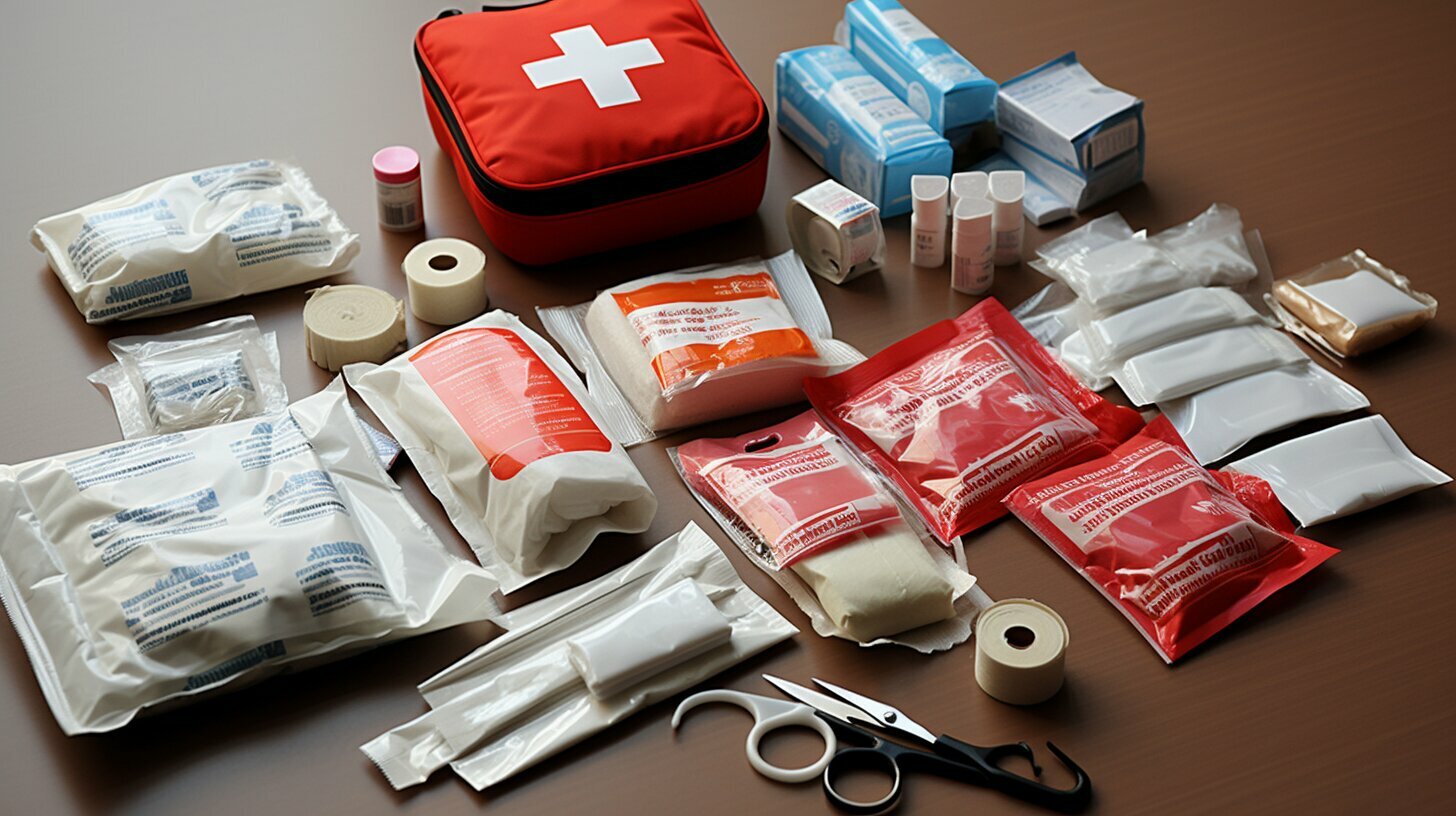
| Item | Description |
|---|---|
| Plasters | Assorted sizes for covering small cuts and abrasions |
| Sterile Dressings | Clean coverings for larger wounds |
| Eye Dressings | Sterile covers for protecting the eyes |
| Bandages | Versatile for applying pressure or immobilizing injuries |
| Gloves | Protective barrier against cross-contamination |
| Tweezers | For removing splinters or foreign objects |
| Scissors | Used for cutting dressings, tape, or clothing |
| Cleansing Wipes | Disinfecting wipes for cleaning wounds |
| Tape | Securing dressings or immobilizing injuries |
| Thermometer | Measuring body temperature |
In addition to these basic supplies, it’s recommended to include additional items in your first aid kit, such as rash cream, insect bite relief, antiseptic cream, painkillers, antihistamine cream or tablets, distilled water for cleaning wounds, and eye wash. These can help provide relief and comfort in specific situations. Regularly checking the expiry dates of medicines in your kit is crucial to ensure their effectiveness when needed.
By stocking your first aid kit with these essential items and following the guidance provided by the NHS, you can be better prepared to handle emergencies and provide initial care in various situations.
Additional First Aid Supplies
In addition to the basic essentials, it is also recommended to include items like rash cream, insect bite relief, antiseptic cream, painkillers, antihistamine cream or tablets, distilled water for cleaning wounds, and eye wash in your first aid kit. These additional supplies can help provide relief and aid in the treatment of various common injuries and ailments.
Rash cream, such as hydrocortisone cream, can be applied to soothe and alleviate the discomfort caused by skin rashes and irritation. Insect bite relief, like antihistamine creams or ointments, can help reduce itching and swelling caused by insect bites.
Antiseptic cream is essential for cleansing and preventing infection in minor wounds and cuts. It helps to kill bacteria and reduce the risk of complications. Painkillers, such as paracetamol or ibuprofen, can provide temporary relief from pain caused by minor injuries or headaches.
Antihistamine cream or tablets are useful for managing allergic reactions, including skin rashes, hives, and hay fever symptoms. Distilled water is recommended for cleaning wounds as it is free from impurities that could potentially worsen the injury. Eye wash is crucial for flushing out foreign objects or substances that may come into contact with the eyes.
| Supplies | Usage |
|---|---|
| Rash cream | Relieves discomfort caused by skin rashes |
| Insect bite relief | Reduces itching and swelling from insect bites |
| Antiseptic cream | Cleanses and prevents infection in minor wounds |
| Painkillers | Provides temporary relief from pain |
| Antihistamine cream or tablets | Manages allergic reactions and hay fever symptoms |
| Distilled water | Cleansing wounds |
| Eye wash | Flushes out foreign objects or substances from the eyes |
Having these additional supplies in your first aid kit can enhance its effectiveness in providing appropriate care for various minor injuries and discomforts. Remember to regularly check the expiry dates of these items and replace them when necessary to ensure their potency and efficacy.
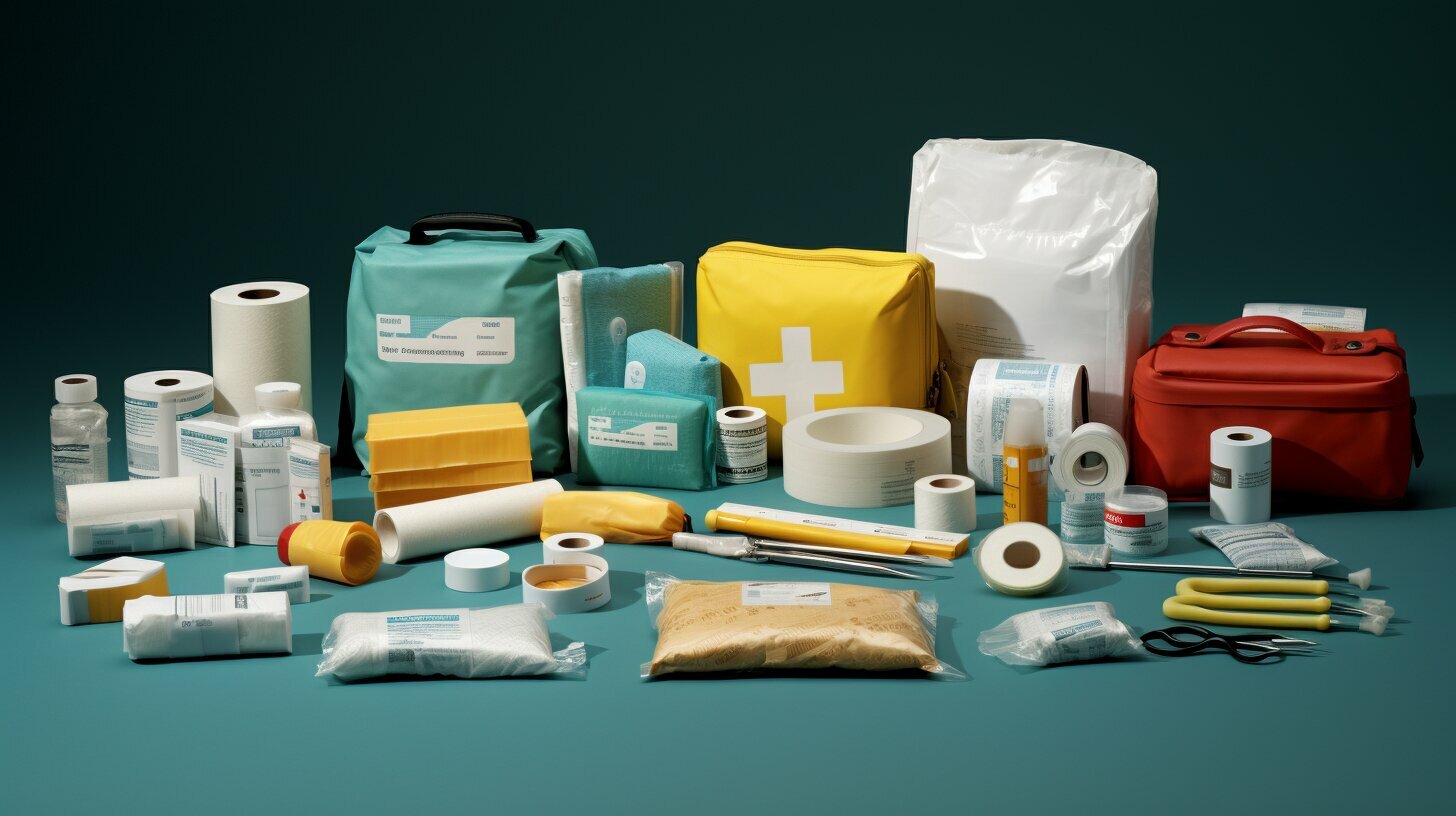
For further guidance on first aid supplies and procedures, and to ensure you are adequately prepared for emergencies, consult the resources available from the NHS. It is important to be knowledgeable and equipped with the necessary tools to provide immediate aid when someone is injured or unwell.
Checking Expiry Dates
To maintain the effectiveness of your first aid kit, it is crucial to regularly check the expiry dates of the medicines included. Expired medicines may lose their potency or even become harmful, rendering them ineffective in providing the necessary relief during emergencies. By ensuring that the medicines in your kit are within their expiration date, you can have peace of mind knowing that they will be ready to use when needed.
It is recommended to inspect your first aid kit at least once every six months and replace any expired medications promptly. This routine check should include a thorough examination of all items within the kit, paying close attention to the expiry dates on medicines. Additionally, take note of any items that have been used or are running low and replenish them accordingly. This proactive approach ensures that you are prepared for any health emergency that may arise.
By regularly monitoring the expiry dates of the medicines in your kit, you can maintain the highest level of effectiveness and reliability in your first aid supplies. This simple step contributes to the overall safety and well-being of yourself, your family, and those around you. Make it a routine to check the expiry dates and restock your kit to ensure that you are always prepared for any situation that requires immediate medical attention.

As an additional reminder, always store your first aid kit in a cool, dry place to prevent the degradation of medications and supplies. Avoid exposing the kit to extreme temperatures or humidity, as this can impact the effectiveness of certain items. By following these guidelines and regularly checking the expiry dates, you can guarantee the readiness and reliability of your first aid kit, providing you with peace of mind in times of health emergencies.
NHS Guidance on First Aid
The NHS provides comprehensive guidance on various aspects of first aid, including the role of appointed persons, the use of defibrillators, treatment of electric shocks, recommended first aid box contents, and essential first aid equipment. These guidelines aim to ensure that individuals are equipped with the necessary knowledge and tools to effectively respond to emergencies and provide immediate care to those in need.
Appointed persons play a crucial role in first aid response, as they are responsible for assessing the situation, providing initial care, and ensuring that appropriate medical help is sought when necessary. It is important to have trained individuals readily available in workplaces, schools, and public spaces who can confidently administer first aid until professional medical assistance arrives.
Defibrillators are another essential resource in first aid response. These devices can significantly increase the chances of survival for individuals experiencing cardiac emergencies. The NHS emphasizes the importance of having easily accessible defibrillators in public areas, workplaces, and schools, and provides guidance on their proper usage.
In the event of an electric shock, prompt and appropriate treatment is vital. The NHS guidance outlines the necessary steps to follow when providing first aid for electric shocks, including ensuring the safety of the responder and the casualty, immediately cutting off the electrical supply, and administering CPR if required.
| First Aid Box Contents | Essential First Aid Equipment |
|---|---|
| – Plasters of various sizes | – Disposable gloves |
| – Sterile dressings | – Tweezers |
| – Eye dressings | – Scissors |
| – Bandages | – Cleansing wipes |
| – Tape | – Distilled water for cleaning wounds |
| – Thermometer | – Eye wash |
These are just a few examples of the comprehensive guidance provided by the NHS on first aid. Whether it’s understanding the proper use of equipment, administering the correct treatment, or ensuring the safety of both the responder and the casualty, the NHS guidelines aim to empower individuals with the knowledge and skills needed to respond effectively in emergency situations.
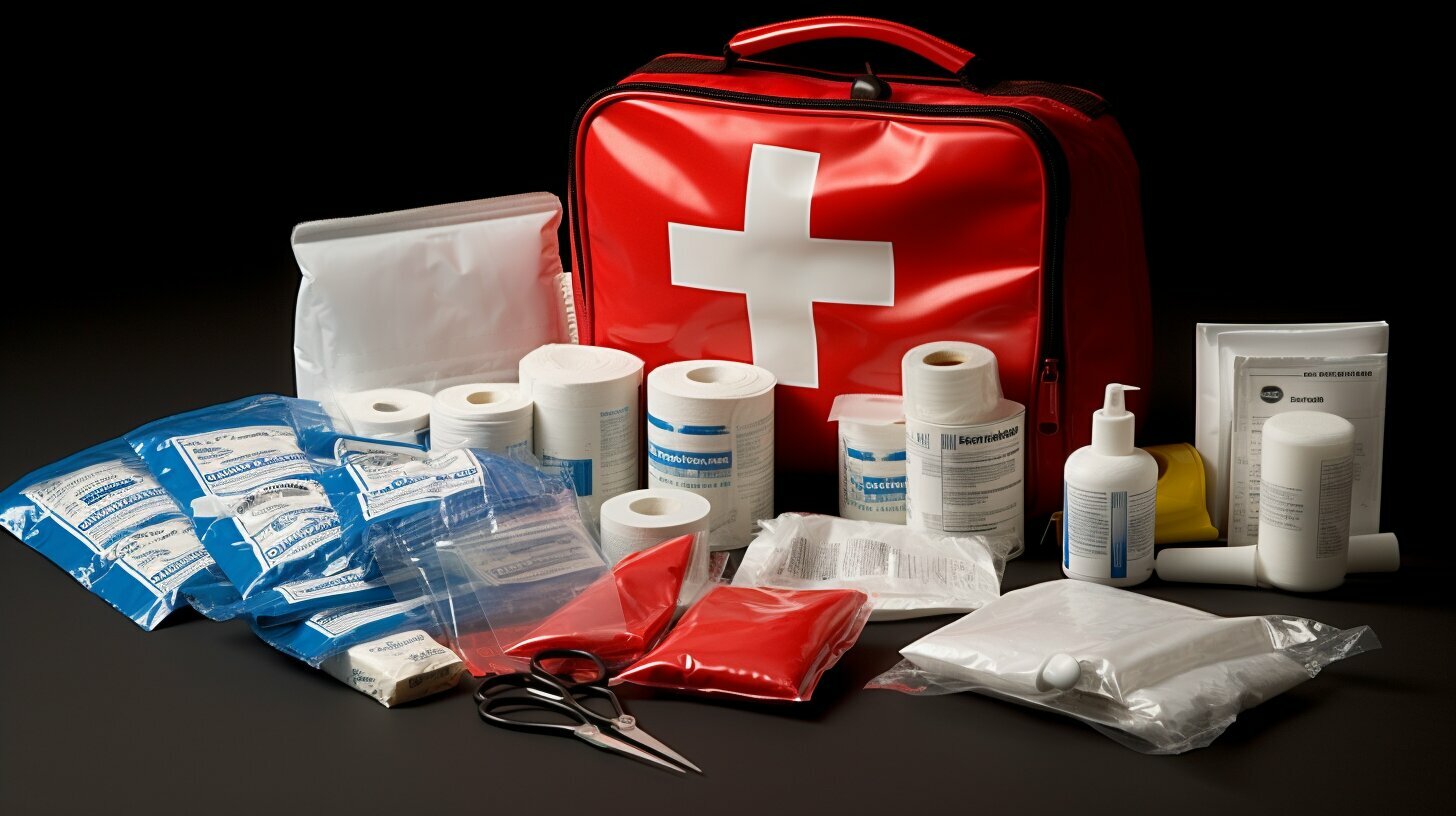
- British Red Cross – Provides first aid courses and resources for individuals and workplaces
- St John Ambulance – Offers first aid training and resources for various settings
- Health and Safety Executive (HSE) – Provides guidance on workplace first aid requirements and regulations
These resources can complement the NHS guidance and further enhance individuals’ knowledge and preparedness in providing first aid care when needed. It is important to continually update and refresh first aid skills through training and staying informed of the latest guidelines and practices.
By following the comprehensive guidance provided by the NHS and utilizing the recommended first aid supplies, individuals can play a crucial role in saving lives, preventing further complications, and providing immediate care in emergency situations.
| First Aid for the Public | First Aid for Traveling or Lone Workers |
|---|---|
| – How to recognize and respond to common emergencies | – Tips for assembling a compact first aid kit for travel |
| – Basic life support techniques | – First aid considerations for individuals working alone |
| – Steps to take in the event of a severe bleeding | – Precautions for remote areas and limited access to medical help |
| – Appropriate action for choking incidents | – Dealing with specific travel-related health concerns |
Whether you’re a concerned parent, a frequent traveler, or an employer looking to ensure the safety of your employees, the NHS provides guidance tailored to various contexts and situations. By familiarizing yourself with these guidelines and being prepared, you can make a significant difference when someone’s health and well-being are at stake.
First Aid for the Public and Special Situations
The NHS offers specific guidance on first aid procedures for the general public, including recommendations for situations like traveling or lone workers, first aid in schools, and the requirements for a dedicated first aid room. Whether you are at home, on the road, or in a workplace, being knowledgeable about first aid can help you respond effectively in emergency situations.
For the general public, it is essential to have a basic understanding of first aid techniques such as CPR, the recovery position, and how to administer first aid for common injuries like burns, cuts, and fractures. The NHS provides step-by-step instructions and advice on their website, ensuring that you have the knowledge required to provide immediate assistance when needed. It is also important to familiarize yourself with location-specific first aid guidance, such as first aid for traveling or lone workers.
In schools, teachers and staff members are often designated as first aiders. The NHS provides guidelines on first aid procedures for educational settings, including how to respond to incidents such as falls, head injuries, and allergic reactions. These guidelines help ensure that schools are well-equipped to handle medical emergencies and provide a safe environment for students.
For workplaces, the NHS outlines specific requirements for a dedicated first aid room. This includes having suitable first aid equipment, such as a first aid kit, eye wash facilities, and a clean area for treating injuries. These guidelines help employers create a safe and secure workplace and ensure that employees receive prompt and appropriate first aid in case of an incident.
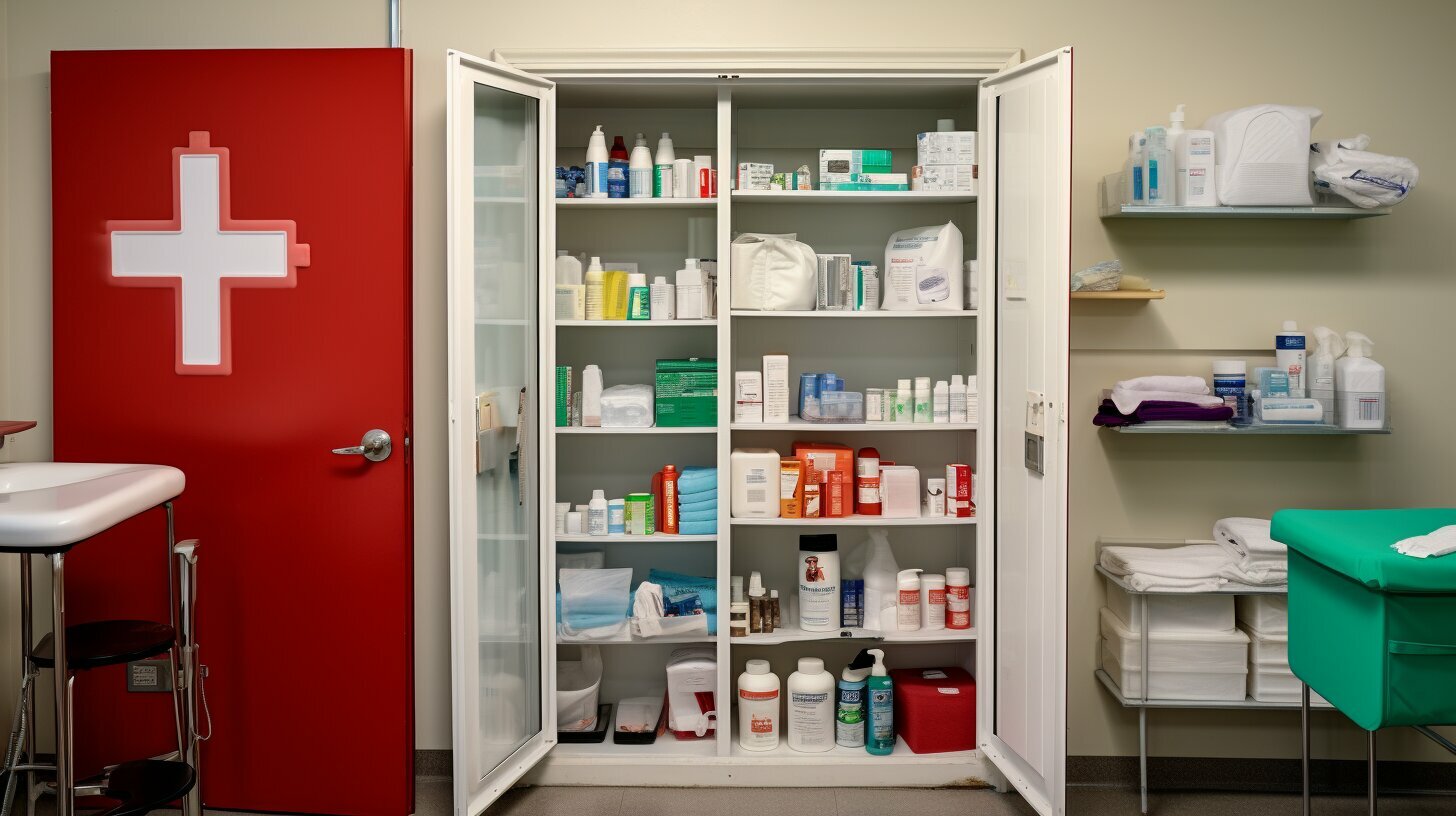
| Key Points: | First Aid for the Public and Special Situations |
|---|---|
| 1 | The NHS provides guidance on first aid procedures for the general public and offers specific recommendations for situations like traveling or lone workers, first aid in schools, and the requirements for a dedicated first aid room. |
| 2 | It is important for the public to have a basic understanding of first aid techniques and to familiarize themselves with location-specific first aid guidance. |
| 3 | Schools should have designated first aiders who are trained in responding to common incidents, while workplaces should have a dedicated first aid room equipped with suitable first aid supplies. |
Ensuring Safety and Cross-Infection Prevention
Safety is paramount in first aid procedures, and measures such as using appropriate first-aid signs, determining the required number of first-aiders, understanding legal implications for first-aiders, and minimizing the risk of cross-infection are essential considerations.
When it comes to first-aid signs, they play a crucial role in guiding individuals to the location of first aid facilities, ensuring quick access to essential supplies. These signs should be prominently displayed and easily visible, using both text and internationally recognized symbols to convey the message effectively.
The number of first-aiders needed in a particular setting depends on various factors, such as the size of the premises, the number of employees or occupants, and the potential risks involved. It is recommended to conduct a thorough risk assessment to determine the appropriate number of trained individuals who can provide first aid promptly during emergencies.
It is also important for first-aiders to be aware of the legal implications involved in providing first aid. While their intention is to provide immediate assistance and support, there are certain legal considerations to keep in mind. If a first-aider acts negligently or fails to provide appropriate care, they can potentially face legal action. Therefore, it is crucial for first-aiders to receive proper training and follow established protocols to minimize the risk of legal repercussions.
Minimizing the risk of cross-infection is another vital aspect of first aid procedures. Cross-infection occurs when harmful microorganisms are transferred from one person to another, potentially leading to the spread of infectious diseases. To prevent cross-infection, it is important to use personal protective equipment, such as gloves and face masks, when providing first aid. Additionally, proper hand hygiene and the appropriate disposal of contaminated materials are essential in reducing the risk of infection transmission.

| First Aid Measures | Considerations |
|---|---|
| Using appropriate first-aid signs | Ensure visibility and easy access |
| Determining the required number of first-aiders | Conduct a risk assessment |
| Understanding legal implications for first-aiders | Receive proper training and follow protocols |
| Minimizing the risk of cross-infection | Use personal protective equipment and practice proper hygiene |
Conclusion
Following the recommendations of the NHS and ensuring you have the necessary first aid supplies can greatly contribute to being prepared for potential health emergencies. The UK’s National Health Service advises having a well-stocked first aid kit in your home, car, and workplace. A basic first aid kit should include plasters of various sizes, sterile dressings, eye dressings, bandages, gloves, tweezers, scissors, cleansing wipes, tape, thermometer, rash cream, insect bite relief, antiseptic cream, painkillers, antihistamine cream or tablets, distilled water for cleaning wounds, and eye wash. These supplies can assist in providing immediate care during emergencies and can potentially save lives.
It is also essential to regularly check the expiry dates of medicines in your first aid kit. Expired medications may not be effective when needed, compromising the quality of care provided. By ensuring that all items are up to date, you can be confident in the efficacy of your first aid supplies.
The NHS provides comprehensive guidance on various aspects of first aid, including appointed persons, defibrillators, electric shock treatment, first aid box contents, first aid equipment, first aid for the public, first aid for traveling or lone workers, first aid in schools, and first aid room requirements. This guidance ensures that individuals are equipped with the knowledge and skills to respond effectively in emergency situations, promoting safety and well-being.
Additional Resources for First Aid Guidance
If you would like to obtain further guidance on first aid procedures and supplies, there are additional resources available. Organizations such as St John Ambulance and the British Red Cross offer training courses and materials that can enhance your first aid knowledge. These resources provide valuable information on various topics, including CPR, wound care, and emergency response protocols.

| First Aid Kit Essentials | Additional First Aid Supplies |
|---|---|
|
|
By adopting the recommendations and guidance provided by the NHS, you can ensure the safety and well-being of yourself and others during emergencies. Being prepared with the necessary first aid supplies and knowledge can make a significant difference in the outcome of a health emergency.
Additional Resources for First Aid Guidance
There are additional resources available to help individuals access comprehensive guidance on first aid procedures and recommended supplies. Whether you are looking for information on specific first aid techniques or need assistance in building a well-stocked first aid kit, these resources can provide valuable insights and expert advice.
One reliable source of information is the British Red Cross, which offers a range of first aid courses and resources tailored for different needs. Their website features step-by-step guides on various first aid techniques, such as CPR and choking, as well as tips on how to manage common injuries and emergencies.
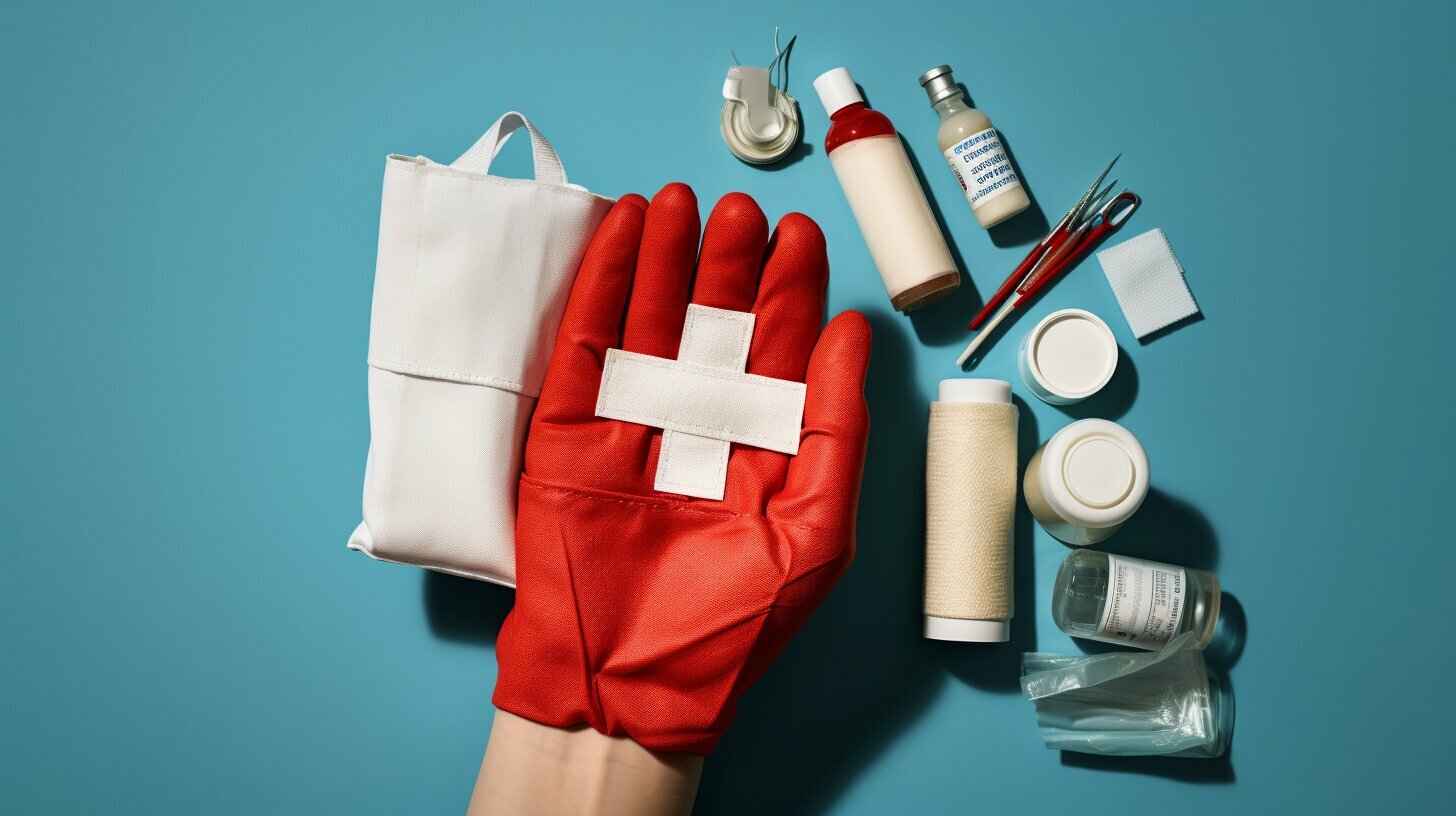 Another helpful resource is St John Ambulance, a renowned organization dedicated to teaching first aid skills. They provide free online resources, including instructional videos and interactive quizzes, to help individuals gain essential knowledge in emergency situations.
Another helpful resource is St John Ambulance, a renowned organization dedicated to teaching first aid skills. They provide free online resources, including instructional videos and interactive quizzes, to help individuals gain essential knowledge in emergency situations.
Furthermore, the NHS website offers a wealth of information on first aid, including detailed guidance on specific topics such as first aid for burns, fractures, and allergic reactions. They also provide downloadable first aid leaflets that cover a wide range of scenarios, ensuring that you are well-prepared for any unexpected situation.
| Resource | What They Offer |
|---|---|
| British Red Cross | Step-by-step guides, courses, and tips on first aid techniques and injury management. |
| St John Ambulance | Free online resources, including videos and quizzes, to enhance your first aid knowledge. |
| NHS | Detailed guidance, leaflets, and information on various first aid topics and scenarios. |
By utilizing these additional resources, you can ensure that you are equipped with the necessary knowledge and skills to provide effective first aid when it matters most. Remember, being prepared and having access to reliable guidance is key to safeguarding the health and well-being of yourself and others.
Endnote
In conclusion, prioritizing emergency preparedness by following the NHS recommendations for first aid supplies is crucial to ensure the safety and well-being of yourself and others in various situations. The UK’s National Health Service (NHS) advises having a well-stocked first aid kit in your home, car, and workplace. This kit should include essential items such as plasters of various sizes, sterile dressings, eye dressings, bandages, gloves, tweezers, scissors, cleansing wipes, tape, thermometer, rash cream, insect bite relief, antiseptic cream, painkillers, antihistamine cream or tablets, distilled water for cleaning wounds, and eye wash.
Regularly checking the expiry dates of medicines in your first aid kit is also crucial to ensure their effectiveness when needed. The NHS provides comprehensive guidance on various aspects of first aid, including appointed persons, defibrillators, electric shock treatment, first aid box contents, first aid equipment, as well as specific guidance for the public, traveling or lone workers, schools, and first aid room requirements.
Furthermore, it is important to ensure safety during first aid procedures by following guidelines on first-aid signs, determining the appropriate number of first-aiders, and minimizing the risk of cross-infection. By staying prepared and well-informed, you can confidently handle emergencies and provide initial care before professional medical help arrives.
